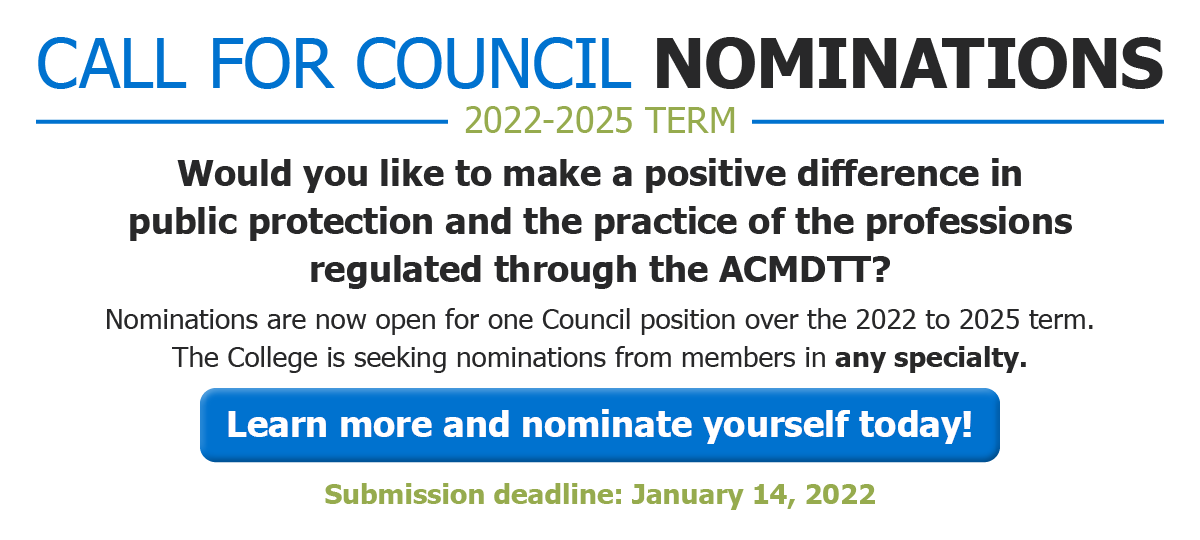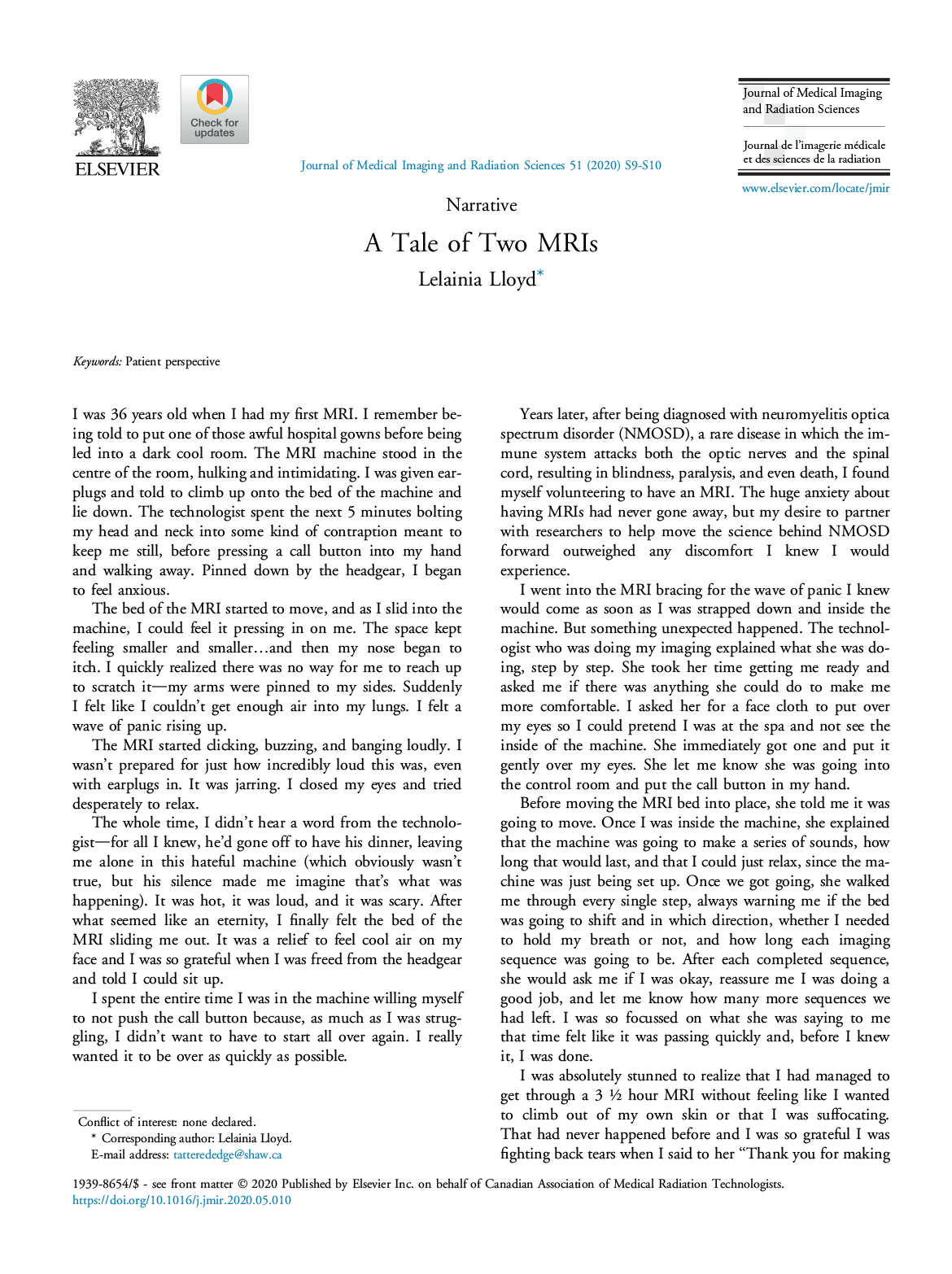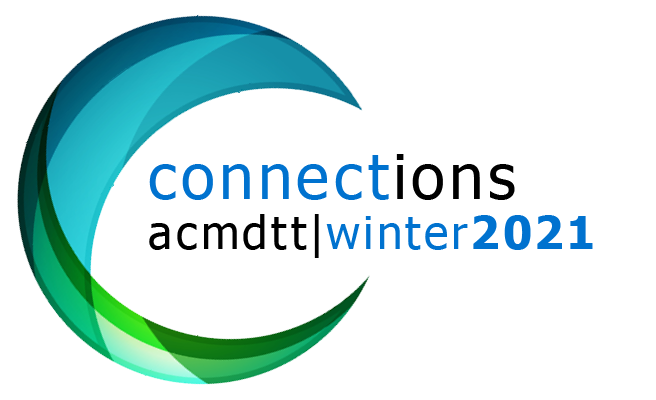
Amendments to the Health Professions Act (HPA) introduced by Bill 46, the Health Statutes Amendment Act, 2020 (No. 2), require that health profession colleges only carry out professional regulatory duties in the public interest and prohibit them from carrying out association and member services functions. The College has already taken steps to comply with this new legislation — including discontinuing branches, annual membership meetings, conferences, and the associate membership category — and work continues as the government provides new details and timelines.
The Minister of Health has approved a two-phased approach to the implementation of Bill 46. Cabinet approved the proclamation of the Phase 1 amendments on October 1, 2021. Colleges will have six months from the date of proclamation to submit a plan for separation to the Minister and a further 12 months to effect the separation. Dual-mandate colleges (colleges that currently act both as regulators and associations, like CARNA and the Alberta Dental Association and College) will likely need the full amount of time allotted to complete the separation; however, as the College has always been solely a regulator that provides limited membership services, we anticipate completing the separation ahead of the government’s deadline.
While work is underway on changes due to Bill 46, regulatory reform continues in Alberta. On October 25, 2021, the Government introduced Bill 49, the Labour Mobility Act (LMA), and proceeded to give the new bill first reading. Bill 49 carries over many of the concepts introduced by Bill 11, the Fair Registration Practices Act (FRPA), but is focused on professionals currently registered in a province or territory in Canada other than Alberta looking to become registered with a regulatory body in our province (labour mobility applicants). While the legislated intention for the FRPA was to try to facilitate the registration of internationally educated graduates, the FRPA currently applies to all applicants for registration with regulatory bodies. Once the LMA comes into effect, the scope of the FRPA will be narrowed to exclude this group.
Bill 49 will establish new and critical registration requirements for all 30 HPA colleges to recognize the credentials and training of out-of-province certified workers. These new requirements include, but are not limited to, determining what information/documentation types or quantities regulatory authorities can request, requiring that Alberta regulators register qualified Canadians who meet all the criteria established in the regulation, introducing maximum timeframes for registration decisions, and requiring appeal processes and processes for internally reviewing applications. Complying with Bill 49 will require dedicated resources, time and training for all health colleges.
As the College continues to take steps to comply with the changes introduced by Bill 46, we will share regular updates about our status.
The College announced over the summer that our bylaws have been updated to reflect that branches will be dissolved on July 1, 2022. In the meantime, branches will continue to operate as they always have. The College has been working with the branch chairs to provide guidance on the transition and answer any questions they have. We have encouraged branches to plan more events for their members between now and June and we will continue to provide support for the digital delivery of these events.
All branches continue to operate under the same set of policies and procedures that have been in place since 2011. Detailed information can be found on the Branches page. Any funds remaining in the branches’ accounts upon their dissolution will be returned to the College. Decisions regarding these funds will be made by Council and published in our annual report.
In addition to making decisions regarding the College’s finances, Council is responsible for making decisions regarding the College’s strategic direction and updates to our foundational documents. In September, Council passed a motion to amend the College’s mission statement and Code of Ethics.
The mission statement was amended to remove the reference to “continually advancing professions.” Advancement of the professions alludes to the professional development of members, which falls within the scope of an association. The new mission statement is as follows:
The Alberta College of Medical Diagnostic and Therapeutic Technologists exists so that the public is assured of receiving safe, competent and ethical diagnostic and therapeutic care by regulated professionals.
A similar reference in the College’s Code of Ethics (“Advancing the profession: A regulated member advances the profession through the development and sharing of new and emerging professional knowledge”) was also removed. While the document was being updated, we also removed the reference to “self-regulation” (“A regulated member recognizes that the self-regulation of the profession is a privilege”) to reflect the changes introduced by Bill 30 that mean regulation of the professions is now a responsibility shared equally by members of the profession and members of the public.
Council plans to review the College’s mandate policy and other documents as necessary in the new year to ensure our compliance with Bill 46.
To learn more and view all updates, please visit the Response to Bill 46 page.
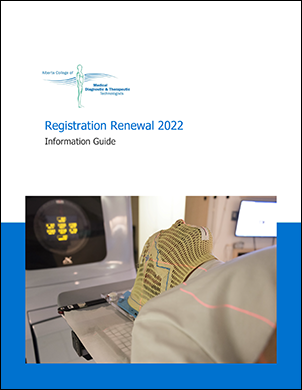 Over 98% of regulated members have renewed their registration by completing all of the legally mandated requirements to practice the profession in Alberta in 2022. This has been another challenging year and we recognize and appreciate the continued dedication and professionalism of MRTs and ENPs in our province.
Over 98% of regulated members have renewed their registration by completing all of the legally mandated requirements to practice the profession in Alberta in 2022. This has been another challenging year and we recognize and appreciate the continued dedication and professionalism of MRTs and ENPs in our province.
The online registration renewal system will remain open until 11:59 pm on Friday, December 31, and all regulated members who have not yet renewed should do so by this deadline. If you hold general registration and have not renewed by this time, please note that as of January 1, 2022, your practice permit will be suspended, and you must cease practice. You will have to contact the College to renew your practice permit. All additional and enhanced practice authorizations that have not been renewed will also be cancelled.
If you want to resign your registration, you should do so online through My Profile as soon as possible. If you are registered as an associate member, your membership will expire automatically and your status will be changed to “Withdrawn” on the public register on January 1. You will need to meet all registration requirements in place at the time of your application before you can reapply for general registration.
For more information, please visit our Annual Renewal page. Please note that the College is closed from Friday, December 24, 2021, to Monday, January 3, 2022, and there will be limited support available during this time.
The 2020-21 Continuing Competence Program (CCP) Audit took place on October 1, 2021. As per College policy, a random audit occurs each year to ensure members are complying with the CCP. To comply with the CCP, all members who hold general registration must complete a reflective practice review every year, which consists of a self-assessment, a learning plan, and learning activities. A CCP cycle runs from September 1 to August 31 of the following year, and all three components must be completed on the My CCP platform by the time a cycle ends.
Members are randomly selected for the audit before a CCP cycle ends, which gives them the opportunity to ensure their reflective practice review will meet the expectations of the Competence Committee before they submit it for review in September. The Director of Education and Competence works closely with each selected member to provide feedback on their submission and ensure each component is complete and ready for the committee to review.
This year, the audit meeting took place virtually through Zoom. The Competence Committee, which consists of regulated members from across the province, began the audit meeting by welcoming three new committee members: Adwait Trivedi, MRT(NM), Ayman Darwish, MRT(R)(MR), and Alexandra Sowrey, MRT(R). The committee carefully reviewed all 49 submissions and deemed 39 submissions satisfactory, six satisfactory with feedback, and four unsatisfactory. Members who received an unsatisfactory review were given time to resubmit their submission, and all resubmissions were completed by October 8, 2021.
The Competence Committee members commented on how well done the self-reflections were for this audit cycle. Thoughtful self-reflection is one of the most important parts of the CCP as it helps a member evaluate how they can apply their learning to their professional practice. Kudos to the members who were audited on a job well done!
While the main focus of the October meeting was the audit, the Competence Committee also had the opportunity to learn more about some new learning activities in the works for members. Pam Walters (P Walters Consulting Ltd.) gave a great presentation to the committee on the upcoming regulatory education modules, which will be available to all members sometime in 2022. Topics for the modules are expected to include professional communication, professional boundaries, patient consent, and professionalism and social media. Once the modules are released, the Competence Committee will be responsible for determining how many learning hours can be used towards a member’s CCP for each one.
If you have any questions regarding the CCP Audit or require assistance in completing your CCP, please feel welcome to reach out to Linda O’Hara, Director, Education and Competence, at lohara@acmdtt.com or 780.487.6130 x. 526.
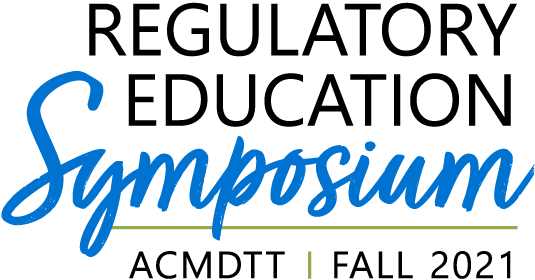 While the College is no longer permitted to provide member-centric services like the annual conference, we are committed to providing new regulatory education opportunities for our members to enhance their understanding of how health regulation ties into their everyday practice. On October 16 and 23, we hosted our first Regulatory Education Symposium, which was an entirely virtual free event that offered members the opportunity to earn up to 8 hours toward their CCP.
While the College is no longer permitted to provide member-centric services like the annual conference, we are committed to providing new regulatory education opportunities for our members to enhance their understanding of how health regulation ties into their everyday practice. On October 16 and 23, we hosted our first Regulatory Education Symposium, which was an entirely virtual free event that offered members the opportunity to earn up to 8 hours toward their CCP.
The event’s presentations included a range of topics:
- Unprofessional conduct and the use of social media
- DI facility accreditation
- Equity, diversity and inclusion in patient care
- Searching for and applying evidence during COVID-19
- Supportive responses to sexual violence: information for health professionals
- College information and update
All presentations were mapped to the College’s Standards of Practice and Code of Ethics or other regulatory documents to ensure our compliance with legislation while making a meaningful contribution to the continuing education of our members. We had 339 people attend the first day of the event and 337 attend the second day of the event, and the feedback we received through the post-event survey indicates that the event was generally well received. We hope to host another symposium this spring, and the feedback we received through the survey will help guide our plans.
 Siobhan is a radiological technologist working in a clinic. Within the next few months, the clinic will be starting to perform cystograms, a procedure that requires the insertion and removal of catheters.
Siobhan is a radiological technologist working in a clinic. Within the next few months, the clinic will be starting to perform cystograms, a procedure that requires the insertion and removal of catheters.
Is this activity within Siobhan’s scope of practice?
The College has approval for members to perform some/all of the restricted activities, as identified in the Medical Diagnostic and Therapeutic Technologists Profession Regulation (the Regulation).
The Regulation states that radiological technologists are authorized to perform the following restricted activity:
14(1)(d) insert or remove instruments, devices or fingers
- (i) beyond the opening of the urethra for the purpose of administrating diagnostic examinations in medical radiology
There is, however, a caveat: in spite of authorization, regulated members must restrict themselves to performing only those restricted activities that they are competent to perform and are appropriate to their areas of practice and the procedures being performed.
What training does Siobhan have to do in order to perform this activity?
A College-approved program is not required as no authorization is needed for insertion/removal of a urinary catheter as this activity is authorized in the Regulation. It is, however, expected that Siobhan will have received appropriate training to perform this activity safely, ethically and competently. The College would encourage the employer to provide adequate training on the procedure and expectations of the technologist in these situations.
In determining whether she has the necessary education and knowledge, Siobhan should ask herself:
- Do I have the knowledge to perform this competently? (i.e., consider anatomy, physiology, infection control)
- Do I have the technical skills to perform this competently? (i.e., mechanics of inserting and removing the catheter and associated risks)
- Do I have the clinical reasoning abilities to perform and maintain this activity competently? (i.e., how frequently would this be practiced, how many cases required to learn this well and competently)
Standards of Practice
Standard 1.1 Patient-Centred Care
To demonstrate this Standard, a regulated member will:
- a. Take steps to put the patient at ease and establish rapport (e.g, introduce oneself, state profession and role).
- b. Assess the patient’s level of understanding of the procedure and adapt communication and assessment accordingly.
- c. Clearly explain the procedure and possible implications to the patient.
- f. Perform procedure in a manner that maintains the patient’s dignity.
Standard 1.2 Clinical Procedures
To demonstrate this Standard, a regulated member will:
- e. Possess the necessary competence to perform the procedure safely and effectively.
Standard 2.2 Professional Competence
To demonstrate this Standard, a regulated member will:
- b. Practice within the limits of the member’s competence.
- c. Maintain knowledge of current and evolving technologies and integrate new learning into practice, as appropriate.
Standard 2.4 Professional Boundaries
To demonstrate this Standard, a regulated member will:
- a. Adhere to the Code of Ethics of the College.
- c. Maintain knowledge of current and evolving technologies and integrate new learning into practice, as appropriate.
Standard 4.2 Safe Practice
To demonstrate this Standard, a regulated member will:
- e. Apply the appropriate infection prevention and control practices in accordance with applicable standards or guidelines and organizational requirements (e.g., employ routine practices and additional (isolation) precautions when required, use aseptic technique and implement protocols for single-use medical devices and for the cleaning, disinfection and sterilization of reusable medical devices).
Code of Ethics
Principle 2 – Responsibility to the profession
- c. Boundaries of competence – A regulated member limits their practice to those techniques and procedures that the member is competent and currently authorized to perform by virtue of education and experience and are consistent with the College’s standards.
Principle 3 – Responsibility to oneself
- b. Accountability – A regulated member takes responsibility and is accountable for their professional activities.
There are many documents that help guide a regulated member’s practice. View these documents on our Resources page or use the Decision-Making Tool to work through a specific scenario.
Lelainia Lloyd
Regulatory links: Standards of Practice 1.1 (a, b, c, e, g), 1.2 (d, h, i), 2.4 (a, b, c), 2.5 (b), 2.6 (b, d); Code of Ethics 1 (a, c), 3 (a, b)
View the article in the Journal of Medical Imaging and Radiation Sciences
© 2020 Published by Elsevier Inc. on behalf of Canadian Association of Medical Radiation Technologists
We often receive queries that indicate there is some confusion about the role of a regulatory body like the College versus an association like the CAMRT or Sonography Canada. Each type of organization performs different functions, but all activities are rooted in one important distinction: a regulator acts in the best interest of the public, while an association acts in the best interest of its members.
Health colleges and their core roles are established under the Health Professions Act (HPA) in Alberta. The HPA delegates regulatory responsibility to colleges and mandates that colleges be accountable to the government. Our college ensures Albertans receive safe, competent and ethical care from MRTs and ENPs by doing the following:
- Registering only qualified and competent technologists who meet the registration requirements
- Setting and enforcing practice and professional standards
- Ensuring MRTs and ENPs are of good character and reputation
- Administering a continuing competence program
- Investigating concerns brought forward by the public, patients and other healthcare professionals
- Supporting MRTs’ and ENPs’ understanding of their responsibilities as regulated professionals
Once a person has been admitted to a health profession, their governing college has an ongoing obligation to the public to ensure that its members remain competent and continue to meet professional and ethical standards. While associations may perform functions that support the mandate of public protection (e.g., issuing certification, providing continuing education opportunities), their focus is on the benefits for their members. MRTs and ENPs have to be members of the College to practice their profession; however, they may choose to be members of their associations.
The distinction between regulators and associations has become even more important now that Bill 46, the Health Statutes Amendments Act, 2020 (No. 2), has come into force. Bill 46 includes several amendments to the HPA, and one of the most relevant for our organization states that colleges will no longer be permitted to perform the functions of an association. This means the College has had to make a plan to discontinue membership services we currently provide.
With all the changes on the horizon, we would like to stress that while our mandate as a health college is to protect the public, members of the College also benefit from being part of a regulated profession. MRTs and ENPs participate in defining and maintaining standards of practice and professionalism within their chosen occupation, allowing for increased confidence in their professional abilities and competencies. Having a regulatory body to establish and administer standards for registration and practice protects the public from incompetent and unqualified practitioners, which in turn makes the profession more highly respected.
The following chart highlights some of the differences between the role of a regulator and the role of an association in Alberta.
| Aspect | Regulator (e.g., ACMDTT) | Association (e.g., CAMRT, Sonography Canada) |
| Mandate | Acts in the best interest of the public. | Acts in the interest of the members of a profession. |
| Accountability | Is accountable to the public through the provincial government. | Is accountable to its members. |
| Activities | Sets the scope of practice, Code of Ethics, Standards of Practice and entry-to-practice requirements legally defined by the Health Professions Act for the practice of a profession. | Serves and supports its members through education, advocacy, professional liability insurance and member benefits. |
| Registration vs. membership | Registers members based on legislated criteria. Membership is mandatory to practice. | Accepts members based on association determined criteria. Membership is voluntary. |
| Permit vs. certification | Issues permits, which are legally required to practice in the jurisdiction. | Issues certification, which encompasses criteria to enter into practice. |
| Qualifications | Sets registration requirements (education, experience, testing to verify competence to practice). | Creates and facilitates certification examinations. |
| Competency profiles | Approves or selects the competency profile(s) for a profession. | Maintains competency profile(s) for a profession. |
| Continuing education | Requires members to participate in legislated programs to ensure continuing competence. | Provides members with opportunities for continuing education. |
| Standards of practice vs. enhancement of practice | Sets legal standards of practice to ensure safe, competent and ethical service for the public. | Provides opportunities to augment competency for members seeking to expand their practice. |
| Protected titles vs. credentials | Establishes professional titles protected in legislation that inform the public of authorized practitioners — e.g., MRT(R), MRT(T), MRT(NM), MRT(MR), ENP, DMS. Practitioners must use these titles in their practice. | Issues credentials to those who have completed the certification (credential) requirements — e.g., RTR, RTT, RTNM, RTMR, RET, CRGS, CRCS, CRVS. Practitioners choose to use these titles in their practice. |
| Enforcement of standards | Has a legislated complaints and discipline processes in place to address complaints from the public and professional conduct issues. | Provides support to members through offering professional liability insurance (PLI). |
| Advocacy | Performs no overt advocacy work. It collaborates with government, professionals and the public to ensure safe, competent and ethical care. | Advocates for the profession in order to effect changes to service delivery, to develop specialty certificates and to increase public awareness of professional services. |
The mandated separation of colleges and membership services has motivated a group of Alberta MRTs to form a steering committee to explore the possibility of creating a provincial MRT association. There were two town hall meetings in November to discuss the idea of the CAMRT providing association services directly to members in Alberta, and the recordings of these meetings can be found on the CAMRT website along with more information about the initiative.
As a regulator with the sole mandate of protecting the public, the College cannot be directly involved in the process of establishing or running a provincial association due to the distinction between the role of a college and an association provided through Bill 46. The College will support the work of the steering committee provided we can do so while complying with legislation.


